Newsletter
Current
Previous
|
December 2007
|
|
Earley
Environmental
Group |
|
Newsletter December 2007
Issue 10
www.earleyenvironmentalgroup.co.uk |
Earley Old English 'Earnley -eagle wood' |
|

ood, glorious food”. With the usual Christmas binge approaching it might be interesting to consider the food we take for granted – perhaps a Christmas pudding flavoured with cognac, or cider, or whisky, Extra Special, or ordinary, vegetarian or organic. We’re spoilt for choice. Jonathan Porritt, in his recent annual lecture at the Museum for Rural English Life, “Exploring Tomorrow’s Low-Carbon Countryside”, spoke of the huge diversity of products in the average supermarket. This is not a given and chances are that, in the future, this may all change. We receive this bountiful choice courtesy of fossil fuel: today’s farming is almost exclusively dependent on it.
Imagine one of the ingredients in your pudding – flour. From wheat in the field to pudding in the supermarket, it is now only possible with fossil fuel. Chemical fertilisers necessary for big yields are produced using fossil fuel, wheat is harvested with fuel-driven tractors, and from then on every stage is powered by fossil fuel: wheat into flour in the mill, flour eventually reaching pudding-maker, pudding to supermarket, to be collected by you in your fossil-fuel-driven car, cooked by fossil fuel. Just one ingredient! Jonathan Porritt thought that, although no-one knows for sure how much oil is left on our planet, at some time it must run out. We may then have to adjust our farming to a low-carbon version. This may be necessary without even taking into account the need for this in order to prevent global warming. He saw a future for more organic farming. As a worst scenario, he pictured a world where we may have to survive on less food, and meat in particular. Perhaps we’ll be healthier and fitter, less obese, as we were during food rationing in WW2. This brings us neatly to the article on p. 6 on food rationing in wartime Earley,  food labelling to avoid wastage (p.4), and also to the story of the heroic efforts of local people to bring you organic food: the True Food Co-op on p.6. For now, enjoy your Christmas fare. food labelling to avoid wastage (p.4), and also to the story of the heroic efforts of local people to bring you organic food: the True Food Co-op on p.6. For now, enjoy your Christmas fare.
|

News of ‘Earley Fox’
Bitterns of Lavell’s Lake and
Dinton Pastures
The Spindle Tree
Food labelling
“The Past is a Foreign Country”, a
continuation of Alan Broodbank’s Earley childhood memories
The True Food Co-Op
Plus usual features – Green Jargon
A Look at Old Earley
News from Beyond Earley and local wildlife sightings
Forthcoming Events, and Bits and Pieces
|
Get to know your Earley
A stroll through something old and something new
A walk to Lavell’s Lake via Black Swan Lake and Sandford Lake.
Lavell's Lake Conservation Area is 46 acres of land near Dinton Pastures Country Park. It has been set aside for wildlife conservation by Wokingham District Council and designated a Local Nature Reserve in 1992. It is managed by the Countryside Ranger Service and Friends Of Lavell’s Lake in consultation with the ROC, BBOWT and the RSPB West Forest Members Group. www.foll.org.uk
Park in Dinton Pastures. At the feeding area for water birds, take the RH path which is parallel to the Golf Course. Just past the Black Swan Sailing Club the path takes a LH bend; a few yards on is a way through to Sandford Lake. You can stroll round here and/or take the path on the east side of Sandford Lake, which takes you out to Sandford Lane (vehicular). Cross here to find the entrance to Lavell’s Lake. Or drive there and park in Lavell’s Lake car park. (Charge of £1). There are two hides at Lavell’s and, if you’re lucky, you’ll see the bittern, usually at the new large hide, which has disabled access from the Lavell’s car park. (See page 2 this newsletter).
Pick up a map in the lobby next to the Cafe at DP.
(See Newsletter Issue 6 Dec 06 for a much longer walk to Lavell’s, written by Liz Wild).
|
|
I am glad to report that ‘Earley Fox’ is alive and well. A letter was received in September:
To EEG
Thank you for asking after me, and for publishing my previous letter. (See Sep 06 Newsletter). This year we raised 4 cubs. We visit several gardens every night. The cubs like to (sic, Earley Fox is obviously not a skilled typist but not many foxes are. Hope he doesn’t take offence!) play with a ball or two and roll about on the back lawns.  In gratitude for help with snacks, we leave the occasional gift of a dead rodent. But no-one knows where we live – that is our secret. In gratitude for help with snacks, we leave the occasional gift of a dead rodent. But no-one knows where we live – that is our secret.
Earley Fox
p.s. Oh, dear one of the cubs has got an injured leg
|
Some Foxy News
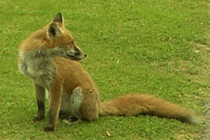 Delightful photos received from an EEG member. Could these be related to "Earley Fox" ? Delightful photos received from an EEG member. Could these be related to "Earley Fox" ?
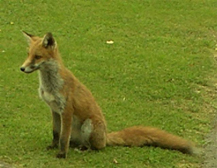
|
|
Bitterns at Lavell’s Lake and Dinton Pastures |
The Bittern in question is the Great Bittern, Botuarus stellaris, a cousin of the Heron and Little Egret. It is a highly-camouflaged, shy species, with the uncanny ability to remain motionless, bill in the air, invisible and cryptic. If you are lucky, you spot movement as a shadowy pattern slips silently between the reeds. Or, if you are really lucky, there it is as a big brown lump, perched halfway up the reeds to preen, or flying like a big brown moth across the water. Once seen, never forgotten! I surprised my first one on the bank of Decoy Broad in Norfolk in 1950 and didn’t see another for almost fifty years. Now I see them often at Lavell’s Lake, where they have visited each winter for five consecutive years.
Bitterns had a hard time of it in post-war Britain. Drainage of wetlands for agricultural purposes reduced their once-widespread reed-bed habitats to a very low level. At one point it was estimated that there were so few “booming” males left in Britain that extinction in this country was a real possibility. They nearly went down the drain with the Marsh Harriers.
One of the problems is that breeding Bitterns need huge areas of habitat, and that exists in relatively few areas of the country: East Anglia was the last natural bastion, with the RSPB reserve at Minsmere, Suffolk a major bridging site for their survival. Huge efforts have been made in the past two decades to make new habitat and to increase available breeding space in such counties as Lancashire and Yorkshire, where I glimpsed a breeding Bittern at the RSPB’s Blacktoft Sands reserve in June this year.
In the winter, it is a different story, since native birds are boosted by birds that come in from mainland Europe to take advantage of our relatively mild maritime climate. Then they can manage with relatively tiny patches of reed – and that is where Lavell’s Lake and Dinton Pastures come in.
In the fifty years following World War Two, there had been only 72 sightings in the whole of Berkshire, and precious few in the Dinton complex, which was no doubt due to the lack of habitat prior to the mid-Eighties. Numbers increased slightly throughout the county by 1996-7 and, from the winter of 1997, Bitterns became regular visitors to Lavell’s Lake. So it was that, nearly half a century on, I saw my second-ever Bittern at Lavell’s Lake in March 1999, and then two together within the same month. Such is their current reliability on the site that I can guarantee an early entry for my year-list. In fact the winter of 2005-6 produced a reliable count, one evening, of five birds roosting in the Dinton complex.
My wife saw her first one on 18th August 2002, while we were walking the dog by the Loddon below Sandford Mill. |
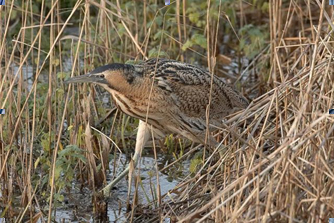 The bird perched in full view for over 30 minutes. It proved to be one of a rare handful of summer sightings in the county. By September two were being noted at nearby Lavell’s, one clearly more mature than the other. In the spring of 2003, one flew off as expected, but the other, a tagged bird, remained throughout the summer. Tragically, we were on another dog-walk when we found it dead by the lake on September 16th. The bird had been radio-tagged in France. Why it had remained for the whole summer remains a mystery, but it may well have been sickening for some time. The bird perched in full view for over 30 minutes. It proved to be one of a rare handful of summer sightings in the county. By September two were being noted at nearby Lavell’s, one clearly more mature than the other. In the spring of 2003, one flew off as expected, but the other, a tagged bird, remained throughout the summer. Tragically, we were on another dog-walk when we found it dead by the lake on September 16th. The bird had been radio-tagged in France. Why it had remained for the whole summer remains a mystery, but it may well have been sickening for some time.
In recent times, grants have enabled conservation work to improve the Bittern habitat at Lavell’s: in a phased programme extensive clearance of trees on the margin of the island preceded the re-profiling of the banks and the planting of extensive new reed-beds. The shallow Teal Scrape at the west end, which had become clogged with crassula weed, was dredged and re-profiled, with space for more reed-beds at the margin. This year the rough area by the path to Tern Hide was re-shaped and the reed-bed there extended. Last, but not least, a superb new hide has been installed at Tern Scrape, which will enable the many visitors to come and see the Bitterns from a more appropriate space.
Though we can for the moment count on the regularity of the Bitterns in winter, will we ever get breeding Bitterns as a result of all the effort? Not a chance, unfortunately. They need acres and acres of reeds. So why so much bother? The answer lies far beyond the pleasure that the wintering Bitterns bring to bird-watchers, or the kudos that they bring to Lavell’s Lake. If we can provide safe refuge for birds to escape the colder climes of further north or of the Continent, there is a greater chance for their survival and a greater chance for all of us to hear that magical booming of the male Bittern. As Sarah Alsbury, the EU LIFE Bittern Project Manager at the RSPB, explains:
The importance of wintering sites, like Lavell's Lake, mustn't be overlooked, After all a young bittern has to leave where it was born at the end of its first summer and has to find somewhere with food and shelter, or it will perish in its first winter. Continental birds, arriving exhausted after a long flight, also need somewhere welcoming. Wintering sites can be much smaller than breeding sites because the birds are not tied to a territory and can move around. But the same principles apply - as much reed (or typha even) with a gentle slope into water full of fish.
Sarah estimated that when 5 bitterns were on site, Lavell's held 5% of the total UK wintering population. If sustained, that could qualify the site for Special Protection Area status under European law, such is its value.
So are we putting all our eggs into one basket by working for one species? Certainly not, as the extra phragmites reeds are also attractive to many other species. Water Rails and Snipe winter in them; Spotted Crakes may stop over in them on passage; Reed Buntings and Reed Warblers will breed in them, attracting the Cuckoos that rely on such birds as hosts; Little Grebes and other water birds will hide in them; Whitethroats, Sedge Warblers, Cetti’s Warblers will feed in them; passage Swallows and wintering Starlings, buntings and finches may roost in them. And not just the birds, but fish, crustaceans, insects, mammals and amphibians will all benefit from their shelter. What is more, reed-beds are wonderful filtration systems to remove the impurities from water that drains from roads and the like, so keeping our lakes fresh and pure for all wildlife.
So make a point of going over this winter to look for this wonderful and enigmatic bird. Though I have seen Bitterns at all times of day, the time just before dusk is often the best, when the birds arrive in the roosting area opposite the hide. You may just see something else while you are there. I have watched Starlings massing to roost against a red sunset and suddenly ambushed by two Sparrowhawks; I have seen a whole flock of Snipe and several Water Rails together; I have seen Woodcock fly out to feed in the dusk; I have seen a Tawny Owl fly over just moments before the local Barn Owls set out to hunt. And there is no other place in the country that I can recall seeing a Bittern and a Spotted Crake showing simultaneously. Take a flask and settle for an hour or so in the wonderful new hide. That time could become really special.
Ray Reedman
My thanks to Fraser Cottington, Chairman of the
Friends of Lavell’s Lake, for his checking of the facts and dates above. If you wish to contribute to the conservation and improvement of this wonderful site, you can join FOLL, which works closely with the Countryside Services in the management of the reserve. In the near future, there will be an extension of the reserve to include the lake at Lea Farm, with the provision of another new hide and scope for many more exciting developments. Once Bittern…
Photo courtesy of Kev Lewis |
The Spindle Tree 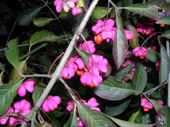
Take a walk around the hedgerows in Meadow Park in October or November and, as likely as not your attention will be taken by a shrub that is truly outstanding in its natural beauty, even when compared to the glorious colours of this year’s fantastic Autumn. That will be Spindle, Euonymus europaeus, which, although I referred to it as a shrub, is just as often known as the Spindle tree. The tree derives its name from its hard, tough, smooth and splinter- resistant wood which was ideal for the making of spindles in the days when spinning was a common occupation, even before the spinning wheel had been invented. Apparently women twirled a stick between their fingers to draw out wool into thread, fixing circular stones with a central hole on to the end of the spindle to give it momentum. Alan Broodbank (Read more about the Spindle Tree on the EEG website).
LABELLING ON FOOD PRODUCTS
Use-by This is the key date in terms of safety: never eat products after this date and observe storage instructions. Check if the food can be frozen if you need to eat it at a later date. 'Use by' dates are usually found on chilled products such as cooked meats, soft cheeses and dairy-based desserts.
Best before 'Best before' dates are usually on longer-shelf-life foods such as frozen, tinned or dried goods and refer to quality rather than safety. So, with these things, it's best to use your judgement. It should be safe to eat food after the 'best before' date, but food may no longer be at its best. One exception is eggs - never eat eggs after the best before date.
Display Until \ Sell by Date marks such as 'display until' or 'sell by' often appear near or next to the 'best before' or 'use by' date. They are used by some shops to help with stock control and are instructions for shop staff, not shoppers.
See website www.lovefoodhatewaste.com
|
GREEN JARGON
WEEE: The Waste Electrical and Electronic Equipment Regulations
Waste electrical goods range from hairdryers to washing machines and make up the fastest growing waste stream in the UK. In one year the amount of electrical waste we create in the UK would fill the new Wembley 6 times! This is a lot of electrical waste! So to reduce the amount of electrical items going to landfill the government has introduced some new regulations called the Waste Electrical and Electronic Equipment Regulations.
The following information was received from re3, the waste partnership between Bracknell Forest, Reading and Wokingham Borough Councils, and may make the local situation clearer.
‘The EU Waste Electrical and Electronic Equipment (WEEE) Directive is a producer-responsibility directive. This means that it makes producers of new equipment pay for the recycling/safe treatment/disposal of the products they sell. Essentially, the directive makes it easier for the public to recycle old electronic goods, as retailers must now either provide a take-back scheme for end-of-life goods, or join a scheme through which they pay for their market share. Through such schemes, many Civic Amenity sites are now designated collection facilities (they are funded by the scheme and therefore no extra cost is passed on to the public). Therefore more electronic goods can be separated from general rubbish, meaning that the hazardous parts can be treated, and that the majority of waste can be recycled instead of sent to Landfill Sites.
Re3 currently provides facilities for the recycling of electronic equipment at both civic amenity sites under its operation; Longshot Lane, Bracknell and Island Road, Reading.’
 www.recycle-more.co.uk www.recycle-more.co.uk
www.recycle-more.co.uk/nav/page1768.aspx
re3.org.uk
The WEEE logo
|

The Wokingham District Veteran Tree Association have landed substantial funding towards carrying on the survey of veteran trees in the District.
Barbara Stagles chair of the Assocation writes:
In October we were delighted to hear that Awards for All, an agent of the National Lottery Fund, had made WDVTA a grant of £9,250.
This, with a grant of £1000 from Wokingham Borough Council, will enable us to buy the hardware, software and technical support to take over responsibility for recording and storing our veteran tree data and passing it on to local and national databases.
Up to September 30th, BTCV (The British Trust for Conservation Volunteers) managed our database from Reading. This was funded in 2005-6 by the Wokingham Society and in 2006-7 by 9 town/parish councils, with support from the District/Borough Council and its officers.
Now WDVTA, with Elaine and Malcolm Butler as our Data Managers, will manage the veteran tree survey closer to its roots! New volunteers for all teams are always welcome.
Phone 0118 9620004 for details. |
THE PAST IS A FOREIGN COUNTRY
A trip down Memory Lane by Alan Broodbank, our Chairman (part 3)
(Alan, as a boy, lived in Hillside Road, and much of his childhood was spent playing in and near the area now known as Maiden Erlegh Nature Reserve) |
The stream itself was of course like a magnet to boys and girls alike, and it was rare indeed to return home without at least one soaking wet foot! Fish were very common, as they are today, but with one major difference. In those days by far the most common species was the minnow, whereas nowadays they seem to have been replaced by sticklebacks. Minnows need fast-flowing well-oxygenated water, whereas sticklebacks will survive happily in a pond; presumably therefore the change is indicative of a slower rate of flow. Certainly I recall the stream being considerably deeper in places than it is now, to the point where it was difficult in places to see the bottom. Occasionally a shoal of roach would appear as if by magic and become stranded in a shallow pool. How they got there was a mystery to us, unless they had swum all the way from the river Loddon, about a mile away. Even more surprising were the occasional appearances of small pike, never more than about two or three pounds in weight. These had almost certainly ascended the stream from the Loddon, presumably to spawn, as we only ever saw them during the breeding season, around March, April and May.
The stream was, as it still is, a home for many species of invertebrate, the most obvious being the Pond Skaters (Gerris lacustris) that whizzed across the surface. Also on the surface, usually in small colonies and only in the still water near the bank, would be found colonies of Water Crickets (Velia caprai) which tended to walk rather slowly, and the extraordinary Whirligig Beetles that always swim in curves and have the appearance of ball bearings rapidly gyrating round one another. Under the surface, sheltering under stones and logs in mid-stream, Freshwater Shrimps (Gammarus) abounded, sharing their niche with Caddis Fly larvae which were instantly recognisable by the protective cases they made for themselves out of sticks, stones, dead leaves and other materials. In the slacker water near the banks their place was taken by Water Lice (Asellus) and other species of Caddis. If one was particularly fortunate, one might find a Water Boatman (Notonecta or Corixa) or a Water Scorpion (Nepa cinerea), with its characteristic tail spine that is in reality a breathing-tube. A sweep with a pond net would often reveal the larvae of aquatic beetles or Dragon and/or Damsel Flies, but we had no means then of determining which species they were. From memory however, I think they included the Emperor Dragonfly (Anax imperator), the Common Blue Damselfly (Enallagma cyathigerum), the Common Ischnura Damselfly (Ischnura elegans) and the Large Red Damselfly (Pyrrhosoma nymphula).
Frogs were encountered frequently, and here again I think they are now more common than they were then. One reason for this could be that, before the housing development, grass snakes inhabited the fields and would have predated on the frogs, possibly having a significant impact on the size of the population. Although several folk had declared, as small boys will, that they had seen adders in the
|
area, I never saw one myself and doubt whether they were present at all. Towards the top of the field, where it was drier, if one were quiet, Common Lizards could be seen on hot days basking in the sunshine, much more easily seen than caught!
Entering the woods via the entrance near the stream, a path of sorts ran along the right-hand bank. A few hundred yards in it opened out into a clearing, where a charcoal-burner had set up his primitive premises. I have a vague notion his name was Mr. Valentine, but could well be mistaken. The burning of the charcoal took place in a number of iron structures; I find it hard to recall the exact size and shape, but in my mind’s eye they were a vertically-standing cylinder about six feet in diameter and ten feet high, with a tall chimney that came off the side. One thing that is absolutely certain is that they were mighty hot and glowed red, and I remember having a narrow escape when one of the chimneys came crashing down in a shower of sparks and flames just as my father and I were walking towards it. Further in still, one arrived at what was known as “The Broken-Down Bridge”. This was a brick structure that straddled the stream, and remnants of it can still be seen today near the tadpole pond. This dark and silent place more or less marked the limit of adventure of even the most pioneering of juvenile explorers. It is difficult nowadays to believe that even if we were playing in this distant spot, we knew when it was time to go home for lunch, as we would hear our mothers calling for us in Silverdale or Hillside Road, a good quarter of a mile distant!
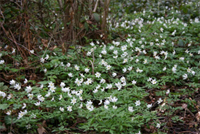
Wood Anemones in the Reserve
As now, Primroses, Bluebells and Wood Anemones made a beautiful sight in springtime but unfortunately did not last long before they were either all picked, dug up or trampled upon. Fortunately that does not seem to happen nowadays, and the removal of much of the invasive Rhododendron has improved their success still further.
Once or twice, accompanied by our fathers, we ventured yet further into the unknown, probably with a view to doing a spot of illicit fishing in the lake that we knew was in there somewhere. Interesting features of the lake that I can recall are a boathouse that would have been somewhere near where Lakeside is now, and the fact that the only species of fish that we ever caught was Rudd. No Roach or Carp at all, although both species became abundant in later years.
(Next instalment: effects of urbanisation on birds, gipsies, and early memories of Sindlesham Mill)
|

Food Rationing in Earley during the early 1940s.
|
 It must have been a pretty lean Christmas-time during World War II. Food rationing was introduced for everyone, including the Royal Family. Ration books were issued, buff for adults and blue for children. Butter, bacon and sugar were the first goods to be rationed in January 1940, followed by meat and preserves in March 1940, tea, margarine and cooking fats in July 1940 and cheese in 1941. Sugar, bacon, butter, cheese and cooking fats were rationed by weight and the relevant coupons entitled the customer to buy a given weight. The most devastating effect for children was sweets and chocolate being rationed: 12oz (350g) per person every four weeks. Sometimes this went down to as little as 2oz per month; sometimes none was available at all. It must have been a pretty lean Christmas-time during World War II. Food rationing was introduced for everyone, including the Royal Family. Ration books were issued, buff for adults and blue for children. Butter, bacon and sugar were the first goods to be rationed in January 1940, followed by meat and preserves in March 1940, tea, margarine and cooking fats in July 1940 and cheese in 1941. Sugar, bacon, butter, cheese and cooking fats were rationed by weight and the relevant coupons entitled the customer to buy a given weight. The most devastating effect for children was sweets and chocolate being rationed: 12oz (350g) per person every four weeks. Sometimes this went down to as little as 2oz per month; sometimes none was available at all.
Householders had to register with their local shops. Once items were purchased the shopkeeper would then cross off and subtract the relevant points used for a product for that particular month. Gerry Westall, a keen local historian, has three registers detailing many local Earley families registered for their food rations at A. E. Bird & Son, Grocers and Provision Merchants,Tobacconists, Church Road, Earley - “Try our own Blended Tea. Chemists’
Sundries. Cooked Hams. Minerals and Cordials.”
|
The registers covered butter, bacon, sugar, cheese, eggs and jam.
“Special cheese” and “invalid butter” were noted against a couple of names.
They were alphabetically indexed by surname, with the initials of all the family members registered. People’s identity numbers were listed, together with ration book numbers. One of the most notable people listed was Ernest W. Dormer at 7 Church Road, knowledgeable in local history matters and author of many items in the Berkshire Archeological Society Journal, of which he became the Editor. His ‘History of the Parish & Church of St. Peter Earley’ pub 1944 is still much sought after.
These were families living near the shop, and the shopkeeper had to keep a strict record of what they were given. The following is a list of just some of the roads covered. There were sometimes only one or two families listed in a road: Church Road, Wilderness Road (the Stables are mentioned) , part Wokingham Road, Mays Lane, Station Road, Ramsbury Drive, Maiden Erlegh Drive, Whiteknights Road, Beech Lane, Betchworth Avenue, Belle Avenue, Hillside Road, Mill Lane, Silverdale Road (no. 6) and Hillside. Farms listed -Radstock Farm,Radstock Lane and Elm Tree Farm, Elm Lane.
|
Even birds had to do their bit in the war
There was a law prohibiting feeding birds during the war. That much persecuted bird, the house sparrow, came under fire. Dubbed 'Hitler's Feathered Friend', householders were told to kill them on site to prevent them destroying much needed crops. How attitudes change!
|
|
|
|
What is it….?
The True Food Co-op is a community enterprise, run by a small dedicated staff and volunteers. It offers a huge range of organic wholefoods, fresh fruit and vegetables (locally grown where possible) and eco-friendly household products at near-wholesale prices, at markets held in community centres across the Reading area. As well as packaged goods, shoppers can buy cereals, grains, beans, pulses, dried fruit and sugar from large containers, weighing out as much as they need.
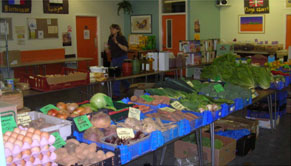
The principal aim of the Co-op is to take affordable organic foods and eco-friendly products to where the people of Reading and surrounding areas live.
Much of our shopping requires us to travel a considerable distance. Using the Co-op reduces the need to travel – which is better for the environment, and gives many more people a real option to go organic and go local.
It is a not-for-profit organisation that reinvests any surplus finances from trading back into the co-operative, and into causes and projects that benefit the community. |
How it all began….
In 1998, Chris Aldridge (now markets manager) saw Reading’s wholefood shops closing down one by one and got together with other people who wanted to buy organic wholefoods locally. The group started out very informally in July 1999 as the True Food Club - TFC. Within a couple of years the club was meeting fortnightly instead of once a month, buying in bulk from the Infinity Foods catalogue – still a major supplier to the Co-op today.
Following the death of Peggy Ellis, an active supporter of the TFC, a new home for club stocks was found at the Rising Sun Arts Centre in Reading.
We have our own market here in Earley at Silverdale Centre on the Maiden Erleigh school site, every Friday at 5-8.15 pm
In 2004 with help from local grant-giving bodies the Club ran a trial of holding food sales at four community venues in different areas of Reading. This showed that there was a big demand for local sales of affordable organic foods. Several business plans and grant applications later the club was formally registered as a Community Co-operative. The Co-op now has a warehouse in Acre Road and a small lorry run on biodiesel made from used cooking oil.
Do come along and see for yourself. www.truefood.coop
Anne Booth (see page 8 for details)
|
|
NEWS FROM BEYOND EARLEY
Humpback Whales in the firing line again: The Japanese are to hunt up to 50 humpback whales in the Antarctic and Southern Oceans for “scientific purposes” (the meat ending up in markets), and four of their ships left for Antarctic waters recently. The ‘singing’ humpback is the most revered whale, and its habit of breaching like a dolphin is an awesome sight for which people pay big money. Greenpeace is intent on stopping the hunting, so the fight is on. This research damages the Japanese image in many people’s eyes, and has provoked a lot of unnecessary and nasty ‘racist’ items on website chat forums. Japanese members of Greenpeace are also involved in the protest.
Tiger numbers plummet in India: Thought to be 100,000 at beginning of the 20th century, it is now believed, after a new count, there may only be 1,300 to 1,500 of this magnificent animal left in India. Big-game hunting must have played a big part, and now continued poaching to supply China and east Asia with their pelts and body parts, and loss of habitat, have contributed to their shrinking numbers. It is thought one a day is being killed by poachers who can make big money supplying tiger body parts. It is frustrating that there never seems to be data published as to the efficacy or otherwise of these parts for medicinal purposes or as aphrodisiacs. |
EARLEY WILDLIFE SIGHTINGS
Duncan 28 Sep: I have recently discovered a cohort of Harlequin ladybirds in my garden. These are non-native ladybirds, which have raised a lot of interest. http://www.harlequin-survey.org/default.htm. I found the dark melanic version. It would be interesting to see what's going on in Earley, don't you think? (Picture on EEG website)
Gillian, October: In her usual monthly survey she noted the following butterflies – Holly Blue (back garden 4.10), Brimstone Yellow (back garden 4.10), Red Admiral (back garden 11.10). Besides the expected bird visitors, more notable ones were a Green Woodpecker (front garden 6.10), Heron on a neighbour’s roof, and Red Kites twice noted flying overhead (5.10 two circling overhead and 17.10 one above back garden). Of particular interest, on 11.10 Gillian had 65-plus Harlequin ladybirds (red, yellow and black) climbing all over the back of her house, and sunning. They continued to be around for a week but in much fewer numbers. Thanks to Gillian for her regular monthly survey in her Earley garden.
Margaret, Meadow Road, mid October: Sighted, while out walking, a fox which crossed the road in Sutcliffe Avenue. This was about 3.45 pm. It wasn’t a cub, and she noted it had a thick brush and looked in good condition. A neighbour in Meadow Rd about the second week of November saw a fox in the garden, which excited the dog enough to chase it, but it survived by shooting over the fence. Margaret thought it’s possible it comes from the Loddon River area.
Margaret H., November: Margaret sent in her regular monthly garden survey; she had the usual garden bird visitors. Of special interest, 2 Crows on lawn (5.11), 2 Dunnocks (7.11), a coal tit on nuts (12.11), Greater Spotted Woodpecker flying low over garden to High Wood (15.11)Jay on fence (16.11), a wren searching for insects in clematis (16.11). She also noted a Speckled Wood butterfly, enjoying the sun and also a warm window-pane (15.11).
Anne, 30 Nov : There was a Red Admiral butterfly flying in the warm sunshine in my garden yesterday.
Sheila, 4 Dec: A large buff-tailed bumblebee foraging in a very late antirrhinum flower. Again, a couple of days later.
|
|
|
Some ideas for Christmas
Shop Locally
|
Recommended wildlife books:
Beechcombings: the Narratives of Trees by Richard Mabey. This has received glowing reviews, as one would expect from Richard Mabey’s pen.
Crow Country by Mark Cocker. Another beautifully written offering, revealing things about one of our common birds which will surprise you. You won’t take this family of birds for granted again.
Wildwood, A Journey Through Trees. Described as ‘At once autobiography, history, a traveller's tale and a work of natural history, "Wildwood" is a lyrical and fiercely intimate evocation of the spirit of trees: in nature, in our souls, in our culture, and in our lives.’ by the late Roger Deakin.
You can obtain these from local bookstore No Page Unturned (see page 8 for address). Emily, the manager, is offering a 15% discount on all books in stock or by order, plus another 5% for EEG members.
Don’t forget the birds:
Give friends bird feeders which can be purchased locally at Pet Fayre (see page 8).
Shop for your organic Christmas food:
The last chance to shop for your organic food at the True Food Co-op market, Silverdale Centre (next to Maiden Erlegh School) is Friday, 21 December, 5 to 8.15 pm. (See p. 6 and 8)
|
LOCAL FORTHCOMING EVENTS
December: Christmas Social Members slides, quiz and Christmas refreshment. Please come along and meet other members with the same interests. Everyone welcome. Tuesday 18 December 7.30 to 9 pm at Interpretation Centre, Instow Road, Take Chelwood Road off Beech Lane, then first left into Instow Road. Follow this round to the farthest corner next to the M.E. Nature Reserve.
January: “Butterflies in Earley and Beyond”. Learn how to recognise those beautiful insects that flit through our gardens in the spring and summer from Grahame Hawker, one of our local experts on the subject. This will be preceded by a brief EEG AGM, which will be dealt with as quickly as possible. Tuesday 22 January 7.30 to approx. 9.15.The venue is the Interpretation Centre, Instow Road, as above.
February: “An Insider’s View” One of our members, Stuart Hines, is manager of the Insect Identification Service at the Natural History Museum and will give us a fascinating glimpse behind the scenes. Thursday 21 February at 7.30 to approx 9.15. To be held at Radstock Parish Room. Take Radstock Lane, (off Beech Lane), follow signs for Earley Town Council Offices and Radstock Primary School. Radstock Community Centre next to school. £1 entry to cover expenses.
March: “RESCUE”: Sunday, March 16. Next year, Earley will once more be joining in with RESCUE (Rivers and Environmental Spaces Clean Up Event). This is a large event, which each year sees hundreds of people helping to clean up their local area, in and around Reading in this case. EEG will again be running events in Earley, so please join in and do something for Earley, making it a more beautiful and tidy place to live. Session times will be 10 a.m. to 12.30 p.m. and 2 to 4.30 p.m. Contact Jean Hackett on 986 1115 if you can help, or e-mail jeanh149@btinternet.com. (Depending on response, we may be able to run it on Saturday as well)
March: “Chernobyl: Before and After”. Tuesday, 25 March 7.30 to approx 9.15.This talk should prove to be a fascinating insight into the terrible catastrophe of 26 April 1986 when one of four nuclear reactors at the Chernobyl power station exploded. Nigel Bell, Professor in Environmental Pollution at Imperial College London, UK representative on Committee of Chernobyl International Radioecology Centre, Slavutych, Ukraine, has an immense knowledge of this subject. Venue the Function Room, Maiden Place Community Centre. Take Kilnsea Drive, off Rushey Way, Laurel Park end, then second turning on right. Follow bend to right until you reach second car park for the Centre which is on left. £1 entry for expenses.
We have a full programme of walks and talks arranged for 2008 which will be announced in our next newsletter. Provisionally, to name some: a talk about the work of the World Land Trust in rainforest conservation (patron Sir David Attenborough), a walk in Pamber Forest, a tour of Maiden Erlegh Reserve and another of Green Park, either a bird-box or hedgehog-box building session, and the annual Green Fair.
|
Bits and Pieces
Anne Booth arranged the bird-box building event we had in February and several members acquired a box to put up in their gardens. If they were used by nesting birds, Anne would be interested to know. Ring her on 0118 986 8260.
Look out for Fairtrade Fortnight on 25 February to 9 March 2008.
Comments or contributions to the newsletter to: sheila.crowson@ntlworld.com or 2 Reeds Avenue, Earley, RG6 5SR. We would welcome short contributions from members to the newsletter.
If you know anyone who would like to join EEG, membership forms are available from Earley Town Council, 0118 986 8995, on the website under Downloads, or send an e-mail to Liz Wild . Please inform Liz if you intend to change e-mail or address at 50 Kenton Rd, Earley RG6 7LG, or send her an e-mail.
Christmas Present to EEG: As you know, we are offer free membership, but would appreciate a small contribution, if you feel inclined, towards our funds.
Can you offer active help to the Group? Phone 0118 9620004 if you can. If you have no expertise and would like to get involved, you may be able to give practical help. We also need people with some expertise to undertake surveys of small habitats in Earley or, for instance, do a hedge survey, |
SUPPORT YOUR LOCAL SHOPS
The True Food Co-op, Silverdale Centre
There is now a True Food Co-op operating in Earley. Their mission is to take low cost organic food out to the people, bypassing the supermarkets which charge a lot for organics They hold markets at the Silverdale Centre now every Friday, 5pm to
8. 15pm. They have a website giving details www.truefood.coop/truefood.html
Pet Fayre 9 Maiden Lane Centre Lower Earley
A small independent shop, with bird feeders of all kinds, a variety of bird feed, large bags of which the shop is willing to deliver locally, or pick it up in your car from the back of the shop Tel 0118 9266512, or email enquiries@petfayre-reading.co.uk.
No Page Unturned: A new bookshop in Earley, 3 Maiden Lane Centre. Emily will get any book you need in 24/48 hrs, 5% off for EEG members.
Phone her on 0118 966 9351 or e-mail emily@nopageunturned.org.uk. Visit her pleasant premises and browse. New and second-hand books, wrapping paper, audio books, etc. |
|
Thanks to ORACLE for reproducing our newsletter on recycled paper. Oracle is the world's second-largest software company, situated at Thames Valley Business Park in Earley. Oracle UK is environmentally accredited to the ISO 14001 standard, which confirms Oracle has considered and acted against its environmental impact. As part of their corporate social responsibility, they support a number of local groups, including us. They have given us valuable support in reproducing the hard copies of our newsletter in colour to distribute to members, libraries, schools etc., as well as printing off posters and membership leaflets. |
|